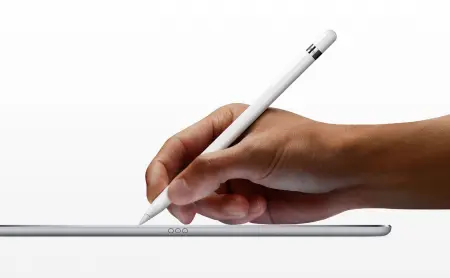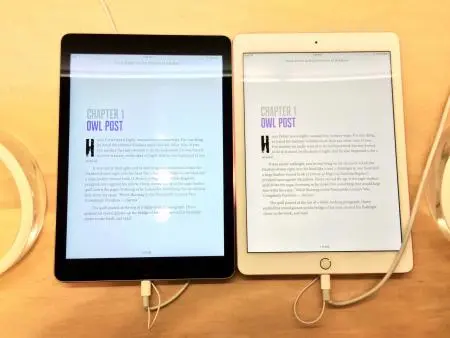all images courtesy Apple.com
Last year, Apple released the iPad Pro, an expanded version of their preexisting tablet, boasting a 12.9 inch screen and a host of other bells and whistles. Tim Cook, the company's CEO, pondered last November "...why would you buy a PC anymore? No really, why would you buy one?" He added that this particular iPad would be "a replacement for a notebook or a desktop for many, many people," citing "creatives"—in particular visual artists and designers—and people who listen to a ton of music/watch a lot of movies, given the larger screen and the four speaker sound system. (Aside: While this sound system is impressive and a marked improvement over previous tablets and even some laptop computers, as an audiophile and self-proclaimed music snob, I'd still jack in a pair of good headphones if I was going to "seriously" listen to some tunes.)
But what of us writers? Are there features of the iPad Pro that we would find appealing? The Apple Pencil, for instance: it's wonderful for artists, but what about handwriting? There's a newly-designed Smart Keyboard you can purchase separately—what does this device offer serial typists? And what of the just-released 9.7 inch iPad Pro (the same size as the previous iPad Air). Does its smaller size and newer mechanics best its bigger brother in any way?
Let's get into the meat of this and answer all these questions and more, shall we? We'll look at the 12.9 inch iteration first, and then the sized-down (but in some ways, more powerful) newcomer.
iPad Pros and Cons (Sorry)
12.9 Inch Model
I'll say this right off the bat—for general computing needs, like surfing the web (which includes Facebook and Twitter, etc.), creating word processing documents, watching movies and, yes, listening to music, this and the smaller iPad Pro will suit your needs just fine. But then again, so will an iPad Air, the now "ancient" predecessor to the Pro tablet line, which you can still readily purchase. All iPad models, when running on iOS 9 and up, offer expanded multitasking capabilities, including the ability to run apps in "split screen," allowing you to write in a word processor while simultaneously viewing a webpage, for instance. You can also press two fingers at the same time onto the on-screen keyboard to access a trackpad-like space that gives you more control over cursor placement and text highlighting, bringing the iPad a few steps closer to its laptop predecessors. And when using an external keyboard, you can utilize the Command + Tab shortcut popular amongst Mac users, which allows you to switch between apps without accessing the iPad's home button.
So yes, the average user might be just fine with an iPad as their sole computer. Where the original Pro is concerned, its 12.9 inch screen is the biggest advantage, particularly for someone who has terrible eyesight (like me) or anyone looking for significant real estate when watching movies and TV shows. But consider that, for a 128GB model—which I'd recommend anyone purchasing over the entry-level 32GB version—the iPad will cost you $949, or $1,079 if you want cellular connection capabilities. Not to mention, if you want an external keyboard, you're looking at an additional $169 for the Apple Smart Keyboard (though I'd steer clear of this keyboard, for reasons I'll get into in a moment). Of course, you can still use any Bluetooth keyboard with the iPad Pro, so assuming you don't already have one, you could buy this Logitech model for about $30 bucks plus shipping via Amazon or any other retailer that carries it in-store. (I do not have direct experience with this particular keyboard, but Logitech makes solid products and I generally trust them).
Finally, consider that you'll probably want a cover to protect the iPad's screen when you're toting it about. For Apple's Smart Cover, you're looking at another $59, or, on the cheaper end of the scale, there's this JETech case on Amazon for about $13 that would probably suit your needs—though be aware that, as a general rule of thumb, the less you pay for something, the faster it's going to wear out, so maybe find something in the middle, between $13 and $59.
But let's say you go the cheap route and buy that JETech case. And let's also say you pick up that $30 Logitech keyboard. All costs combined, you'd be looking at roughly $992 before tax and any shipping costs you might have to pay—and remember, that's assuming you're buying the most inexpensive accessories listed above. Compare this cost to the baseline 11 inch MacBook Air, which also features 128GB of storage space, processing power comparable to the iPad Pro, and retails at $899 before tax. Since this is a laptop computer, it obviously comes equipped with a keyboard, and you don't really have to worry about a case of any kind, so long as you have a bag with space dedicated for your computer and nothing else. Overall, you'd save about $100 going with the MacBook Air, and you'd have the full computing power of a laptop at your fingertips. Sure, the MacBook Air is thicker and heavier than the 12.9 inch iPad Pro, but not by much.
However—and this is when we begin to cover territory pertinent to writers—one must consider the differences in the screens. The Retina technology available in the iPad Pro is significantly easier on the eyes than the LED screens on the MacBook Air. What else do writers do but sit in front of their computers all day long, staring at their screens? (Even handwriters have to transcribe their manuscript at some point.) This issue alone puts the iPad Pro (or again, any iPad model, since they all feature Retina screens now) at an advantage over a MacBook Air.
Does that mean, then, that the 12.9 inch iPad Pro is the ideal machine for a writer? Well...yes and no. It really depends on your personal needs at the end of the day. If you primarily write in Microsoft Word or Apple Pages (or any other word processor available on a mobile platform), then you'd probably manage just fine. More than that, it's quite possible this Pro iteration could be your "one device to rule them all," but only in very specific circumstances.
Let me elaborate on this point by going back to the keyboard situation. Technically—and I mean technically—you could merely use the onscreen keyboard built into the iPad Pro's operating system. The 12.9 inch screen is wide enough to damn near digitally replicate a full-size keyboard. You can't exactly type as you would on a physical keyboard, but with some practice you can actually get up to some decent speeds. But as I detailed in another column, proper ergonomics when typing is essential to one's back, shoulder and neck health, especially over extended periods of time, and you simply cannot achieve proper ergonomic positioning if you're typing on an onscreen keyboard—unless of course you're mirroring the iPad screen onto a separate monitor, which kinda defeats the purpose of having an integrated keyboard-monitor system.
Best to have a separate keyboard to accompany your iPad Pro. As I mentioned earlier, Apple makes a case-keyboard hybrid called the Smart Keyboard, and overall its design is pretty smart. But while it's a nice lightweight option, I found the keys a little too mushy for my taste. Not only this, because the Smart Keyboard doubles as a case, it has to remain attached to the iPad in order to be used, which limits your positioning capabilities and, thus, your comfort. Better to purchase a standalone keyboard that you can position at a distance from the iPad screen, which will allow you to maintain proper ergonomics. You can pick up a Bluetooth mechanical keyboard (this one from Matias looks interesting), which combines the iPad Pro's portability with the ability to type like a speed demon. You can even plug in a USB keyboard, mechanical or otherwise, via the Lightning to USB 3 Camera Adapter, which obviously does more than connect cameras to your device. I own a Razer Black Widow, so I wouldn't want to lug that thing around, but if you find you don't really work outside the house much and you own a similarly bulky keyboard, this won't be a problem. (Note, of course, that because the Camera Adapter isn't technically built to support USB keyboards, you may find that jacking one into your iPad might not work.)
And if you're interested in handwriting in a digital sphere / you also dabble in visual arts (as I do), the Apple Pencil is quite an excellent tool. I'd say the Pencil capabilities is the best thing about the iPad Pro—it's the closest digital corollary to a pen and paper I've ever encountered, especially where handwriting is concerned. You can read up on the ins and outs of the Pencil at Apple's website for a better idea of its capabilities.
The iPad Pro is beginning to sound pretty appealing, yeah? There truly is a lot to love, but again, only in specific circumstances. If you mainly use word processing software to write fiction, screenplays, poetry, or even articles, the iPad is a viable option for you. But if you do a lot of work in web-based site-building or content creation platforms—like LitReactor, for instance, which is built upon the Drupal platform—there are some serious drawbacks to using an iPad over a laptop or desktop. The fact is, mobile operating systems are still much less powerful than their PC counterparts, even for something as simple as multitasking within several programs and windows. Not to mention that you still can't use an external mouse or trackpad on an iPad, meaning that in order to utilize the limited multitasking functions available, you have to move your hands away from the keyboard at a greater distance than if you simply reached for the peripheral sitting right next to your keyboard (meaning, over time, you're working far less efficiently).
Finally—and this is a real kicker for me—reading on a 12.9 iPad Pro is deeply dissatisfying. I've long hoped to basically have a computer that also doubles as my tablet, so when I'm not tapping away on my keyboard, I can have the device in my hands, reading a book or an article (assuming I'm not reading a physical book or magazine, of course). The big bad iPad just isn't comfortable to hold in your hands like most tablets—it's far too tall and wide. It's like holding an old copy of Rolling Stone, only the magazine is made of plastic, metal and glass instead of paper. No good.
I believe it is this very issue—not to mention the high price-point for the 12.9 inch model—that led Apple to develop the...
9.7 Inch Model
...which is more or less a scaled-down version of its big brother, with one key difference: True Tone. What is True Tone? It's a type of display developed for this new iPad Pro model, and it basically adjusts its color output to whatever environment you find yourself in, making the display decidedly less blue and more natural (or, true). This also means that environments with white backgrounds—like eReading apps and word processors—appear visibly more white than previous iPad models, including the 12.9 inch Pro. Check out this side by side comparison photo I took at the Apple Store, with the 9.7 Pro next to the iPad Air:
It isn't the best photo in the world, but you can clearly see the blue tint on the iPad Air on the left, and the warmth of the iPad Pro screen on the right. It actually looks a lot more golden in the photo, but in person that display was pure white. Thus, True Tone makes those long stints of staring at a computer screen even easier on the eyes.
Moreover, the 9.7 inch's body, as I hinted above, is a much more comfortable size for reading, but also for sketching or digital handwriting, because the device rests in your hands much the way a mid-sized journal or sketchbook would. So, True Tone plus a more manageable size, together with all the same features of the 12.9 inch model, makes the 9.7 inch iPad Pro the ideal choice for anyone looking for a computer-tablet hybrid (one that actually works, anyway, unlike certain Microsoft devices, which in my opinion are way too clunky from an interface level to be a viable option at this time).
As far as using the onscreen keyboard, it's not really a tenable, long term option. For sending a quick email it's just fine, but for long-term writing projects, you'll really want an external keyboard. Just as with the 12.9 inch model, Apple designed a Smart Keyboard case to fit with its newest Pro iteration. The keys are more or less identical to the larger version—which means they're just as mushy—and all keys are squished tighter together to fit the 9.7 inch body's frame. It's an okay option, but I'd still advise going with a separate, third party keyboard for all your typing needs.
Just remember, though: the smaller iPad Pro runs on the exact same operating system as its older, bigger brother, so all multi-tasking and web-based computing concerns I discussed above will also apply to the 9.7 inch model. If these aren't issues that will effect your work life in any way, and you're really wanting a hybrid, then the 9.7 inch iPad Pro is definitely the way to go.
Recap
Overall, writers should really consider all their options when thinking about picking up an iPad Pro vs. a laptop or desktop computer. The former offers greater portability, depending on what type of keyboard you want to use, and greatly expands the possibilities of handwriting and note-taking in a digital landscape. And yet, the iPad still doesn't quite compare to a more traditional computer if you're more of a power user.
As to which iPad Pro size would benefit a writer more, I'd have to say the 9.7 inch is a better option overall, especially if you're looking for a device to double as your reading tablet / journal / sketchbook (if you're so artistically inclined), but again, certain computing aspects will be sorely absent in the minimized mobile operating system.
Has anyone else spent some time with the two newest members of the iPad family? What are your thoughts? Do you think either the 12.9 or 9.7 inch iterations would suit your writerly needs? Or are you in the power user camp, and still need a traditional laptop or desktop? Let us know what you think in the comments section below.

About the author
Christopher Shultz writes plays and fiction. His works have appeared at The Inkwell Theatre's Playwrights' Night, and in Pseudopod, Unnerving Magazine, Apex Magazine, freeze frame flash fiction and Grievous Angel, among other places. He has also contributed columns on books and film at LitReactor, The Cinematropolis, and Tor.com. Christopher currently lives in Oklahoma City. More info at christophershultz.com










